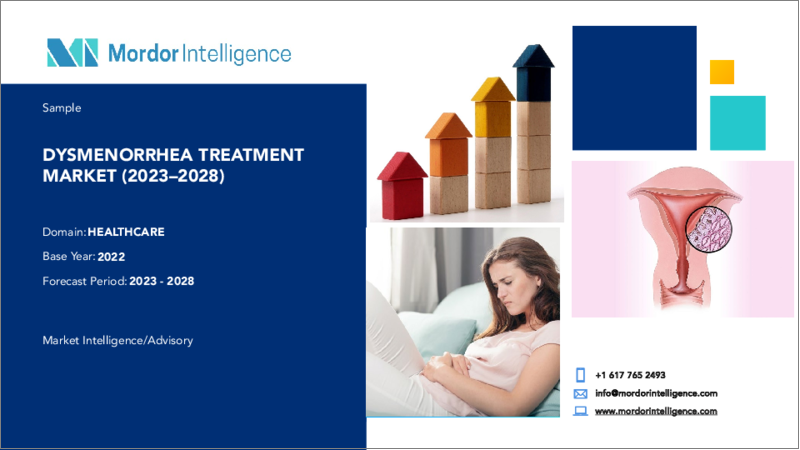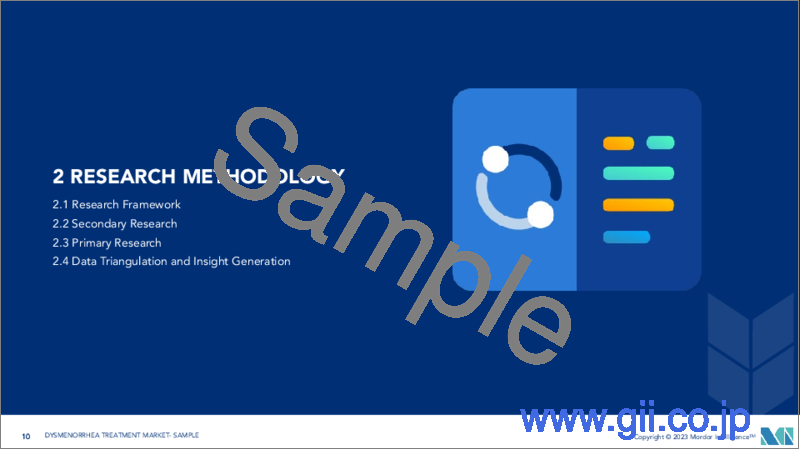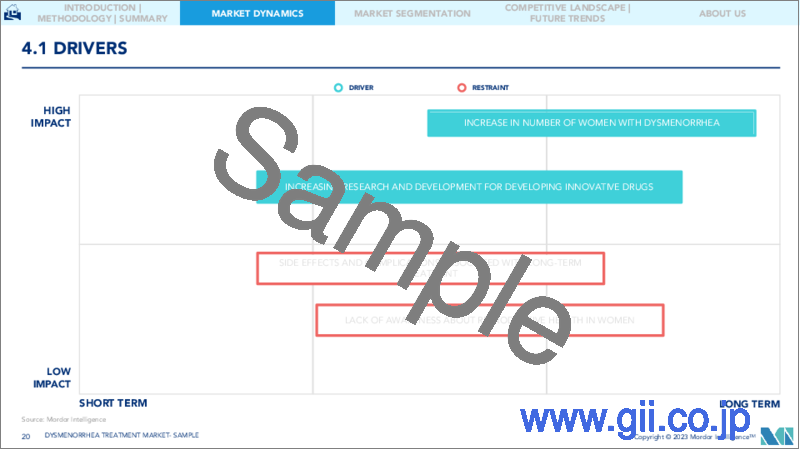|
|
市場調査レポート
商品コード
1190662
月経困難症治療市場- 成長、動向、予測(2023年-2028年)Dysmenorrhea Treatment Market - Growth, Trends, and Forecasts (2023 - 2028) |
||||||
|
● お客様のご希望に応じて、既存データの加工や未掲載情報(例:国別セグメント)の追加などの対応が可能です。 詳細はお問い合わせください。 |
|||||||
| 月経困難症治療市場- 成長、動向、予測(2023年-2028年) |
|
出版日: 2023年01月18日
発行: Mordor Intelligence
ページ情報: 英文 105 Pages
納期: 2~3営業日
|
- 全表示
- 概要
- 目次
月経困難症治療薬市場は、予測期間2022年から2027年にかけてCAGR8.1%で成長すると予想されています。
COVID-19は、何百万人もの人々に肉体的・精神的な影響を及ぼしている前代未聞の健康上の懸念事項です。このパンデミックは、多くの人々の精神衛生に大きな影響を与え、孤独感、社会的孤立、経済的負担、ウイルス感染への不安や恐怖、将来への不安などをもたらしています。ストレスや心理的苦痛を感じる時期が、女性の月経の健康状態に影響を与えることが証明されています。ストレス要因は、視床下部-下垂体-性腺軸(HPG)を活性化し、ゴナドトロピン放出ホルモン(GnRH)の調節を促す神経調節カスケードを変化させ、結果として月経周期が不規則になる可能性があるのです。月経周期の変化は、月経困難症の発症率の上昇につながり、市場に大きな影響を及ぼします。2021年3月に発表された「The Impact of the COVID-19 Pandemic on Women's Reproductive Health」と題する研究によると、パンデミック開始以降、女性の46%が月経周期の変化を報告し、30%が新たに月経困難症に罹患したとのことです。このように、COVID-19は月経困難症治療薬市場に大きな影響を及ぼしています。
月経困難症治療薬市場は、月経困難症の女性の有病率の増加と、月経困難症治療のための革新的な薬剤の開発のための研究開発の上昇によって、大きく牽引されています。
2019年5月にInternational Journal of Gynecology &Obstetricsに掲載された「Prevalence and Predictors of Dysmenorrhea, Its Effect, and Coping Mechanisms among Adolescents in Shai Osudoku District, Ghana」というタイトルの研究の通り、生殖年齢にある女性の80%以上に月経困難症が生じており、世界で最も多い婦人科疾患となっているのだそうです。2021年7月に発表された「Fixed-Dose Combination of NSAIDs and Spasmolytic Agents in the Treatment of Different Types of Pain-A Practical Review」と題する研究により、非ステロイド性抗炎症薬(NSAIDs)と鎮痙薬の様々な組み合わせが開発・試験されており、最新の有効な組み合わせを開発するとともに既存の固定用量組み合わせ薬の新しい適応症を模索する、今後の研究において大きな可能性が示され月経困難症治療への応用が期待されています。このように、既存の月経困難症治療薬の可能性を浮き彫りにする研究や、新薬の開発は、市場を牽引する可能性があります。
しかし、長期治療に伴う副作用や合併症、女性のリプロダクティブヘルスに対する意識の低さなどが、予測期間中の市場成長を抑制するものと思われます。
主な市場動向
月経困難症治療薬市場では、非ステロイド性抗炎症薬セグメントが主要な市場シェアを占めると予想されるています。
月経困難症の治療薬として米国食品医薬品局(FDA)が承認しているNSAIDsには、ジクロフェナク、イブプロフェン、ケトプロフェン、メクロフェナマート、メフェナム酸、ナプロキセンがあります。
2020年12月にWomen's Health ConcernとBritish Menopause Societyに掲載された論文によると、月経困難症の女性の約80%が一生のうちどこかの段階で生理痛を経験するとされています。40%の女性では、生理痛に、腹部膨満感、乳房圧痛、胃の腫れ、集中力の欠如、気分の落ち込み、不器用、疲れやすいなどの月経前症候群の症状が伴います。そのため、月経困難症は初期の段階で治療する必要があり、NSAIDsの使用量が増加し、このセグメントの成長を促進すると予想されます。成人女性における月経困難症」と題された研究論文の通りです。2022年2月に最終更新された「Treatment」によると、NSAIDsはより効果的に月経困難症関連の痛みを治療することができます。約80の試験で、原発性月経困難症患者に対してNSAIDsがプラセボよりも有効であることが報告されています。2019年9月、バイエルは、原発性月経困難症による月経痛に対して、アリーブ(ナプロキセンナトリウム)の最大非処方量1回の投与で、アセトアミノフェンよりも12時間にわたる鎮痛効果が高いことを示すデータを示しました。このように、NSAIDsの高い効能は、NSAIDsの採用率を容易に高め、市場の成長を後押しする可能性があります。
さらに、続発性月経困難症の主な原因である子宮内膜症などの疾患の有病率も、世界的に上昇しています。2021年7月に発表された「Understanding Endometriosis--the Basics」という記事によると、子宮内膜症は生殖期の女性の10人に1人、世界で約1億7600万人が罹患していると推定されています。この要因は、市場の成長に大きな影響を与えることが予想されます。したがって、上記の要因により、非ステロイド性抗炎症薬部門は市場の成長に大きく貢献すると予想されます。
予測期間中、北米が市場で重要なシェアを占める見込まれています。
月経困難症治療薬市場では、北米が大きなシェアを占めると予想されます。米国は、月経困難症の発生率や有病率の増加、女性の月経困難症に対する意識の高まりから、この成長に大きく貢献すると予想されます。
The Prevalence and Academic Impact of Dysmenorrhea in 21,573 Young Women」と題された研究によると、月経困難症の有病率と学業への影響について、以下のように報告されています。2019年8月に発表された「A Systematic Review and Meta-Analysis」によると、月経困難症の有病率は米国で71.1%でした。月経困難症の割合は、学校の生徒と大学の生徒でほぼ同じで、75%前後と著しく高いことがわかりました。月経困難症の高い有病率は、その治療に対する需要を増加させ、市場を牽引しています。また、新薬の開発や既存の治療法の可能性を評価するための研究開発手続きの増加も、調査対象市場を後押しする可能性があります。例えば、2019年1月に発表された「Continuous vs. cyclic combined hormonal contraceptives for the treatment of dysmenorrhea:a systematic review」と題する研究では、柔軟/拡張複合ホルモン避妊薬(CHC)が周期的レジメンと比較して月経困難症の日数を4日減少させることが示唆されています。このような調査研究は、市場の成長に大きく貢献することが期待されます。
さらに、原発性および続発性月経困難症に伴う痛みを治療するための新製品が発売されたことも、研究対象市場を牽引しています。例えば、2021年9月、Myovant Sciences社とPfizer社は、子宮内膜症に関連する中等度から重度の疼痛を管理するためのMYFEMBREE(relugolix 40 mg、Estradiol 1 mg、Norethindrone acetate 0.5 mg)の新薬追加申請(sNDA)審査に関して、米国食品医薬品局(FDA)から承認を取得しました。
したがって、このような要因から、米国の月経困難症治療薬市場は予測期間中に大きく成長することが期待されます。
競合情勢
月経困難症治療薬市場は競争が激しく、複数の大手企業で構成されています。主要なプレーヤーには、Novartis AG、Bayer AG、Abbott Laboratories、F. Hoffmann-La Roche Ltd、Sanofi、Pfizer Inc、GlaxoSmithKline PLC、Focus Consumer Healthcare、Johnson &Johnson、Alvogenなどが挙げられます。
その他の特典
- エクセル形式の市場予測(ME)シート
- アナリストによる3ヶ月間のサポート
目次
第1章 イントロダクション
- 調査の前提条件と市場の定義
- 調査対象範囲
第2章 調査手法
第3章 エグゼクティブサマリー
第4章 市場力学
- 市場概要
- 市場促進要因
- 月経困難症患者の増加
- 革新的な医薬品を開発するための研究開発の増加
- 市場抑制要因
- 長期的な治療に伴う副作用と合併症
- 女性のリプロダクティブ・ヘルス(性と生殖に関する健康)に対する認識不足
- ポーターのファイブフォース分析
- 新規参入業者の脅威
- 買い手/消費者の交渉力
- 供給企業の交渉力
- 代替品の脅威
- 競争企業間の敵対関係
第5章 市場セグメンテーション(金額ベース市場規模- 百万米ドル)
- 治療薬タイプ別
- 非ステロイド性抗炎症薬(NSAIDs)
- ホルモン療法
- タイプ別
- 原発性月経困難症
- 続発性月経困難症
- 地域別内訳
- 北米
- 米国
- カナダ
- メキシコ
- 欧州
- ドイツ
- 英国
- フランス
- イタリア
- スペイン
- その他の欧州地域
- アジア太平洋地域
- 中国
- 日本
- インド
- オーストラリア
- 韓国
- その他アジア太平洋地域
- 中東・アフリカ地域
- GCC
- 南アフリカ共和国
- その他の中東・アフリカ地域
- 南米地域
- ブラジル
- アルゼンチン
- その他の南米地域
- 北米
第6章 競合情勢
- 企業プロファイル
- Novartis AG
- Bayer AG
- Abbott Laboratories
- F. Hoffmann-La Roche Ltd
- Sanofi
- Pfizer Inc
- GlaxoSmithKline PLC
- Focus Consumer Healthcare
- Johnson & Johnson
- Alvogen
第7章 市場機会と今後の動向
The dysmenorrhea treatment market is expected to register a CAGR of 8.1% during the forecast period, 2022-2027.
COVID-19 is an unprecedented health concern that has affected millions of people physically and mentally. The pandemic has significantly impacted many people's mental health, resulting in loneliness, social isolation, financial strain, anxiety and fear of contracting the virus, and uncertainty for the future. It has been proven that periods of stress and psychological distress can affect a woman's menstrual health. Stressors can activate the hypothalamic-pituitary-gonadal (HPG) axis and alter the neuro-modulatory cascade that drives gonadotropin, releasing hormone (GnRH) regulation, which results in an irregular menstrual cycle. The changes in menstrual cycles lead to higher episodes of dysmenorrhea, significantly impacting the market. As per the study titled "The Impact of the COVID-19 Pandemic on Women's Reproductive Health", published in March 2021, 46% of women reported a change in their menstrual cycle, with 30% new dysmenorrhea cases, since the beginning of the pandemic. Thus, COVID-19 has impacted the dysmenorrhea treatment market significantly.
The dysmenorrhea treatment market is significantly driven by the increasing prevalence of women with dysmenorrhea and the rising R&D for the development of innovative drugs for treating menstrual cramps.
As per the study titled "Prevalence and Predictors of Dysmenorrhea, Its Effect, and Coping Mechanisms among Adolescents in Shai Osudoku District, Ghana", published in the International Journal of Gynecology & Obstetrics in May 2019, dysmenorrhea affects more than 80% of women in the reproductive age, and it is the most common gynecological problem worldwide. As per the study titled "Fixed-Dose Combination of NSAIDs and Spasmolytic Agents in the Treatment of Different Types of Pain - A Practical Review", published in July 2021, various combinations of non-steroidal anti-inflammatory drugs (NSAIDs) and spasmolytics have been developed and tested, demonstrating a huge potential for future research to develop modern, effective combinations and search for new indications for the existing fixed-dose combination drugs for treating dysmenorrhea. Thus, research studies highlighting the potential of existing treatments for menstrual cramps and developing new drugs may drive the market.
However, side effects and complications associated with the long-term treatment and lack of awareness about reproductive health in women are expected to restrain the market's growth during the forecast period.
Key Market Trends
Non-steroidal Anti-inflammatory Drugs Segment is Expected to Hold a Major Market Share in the Dysmenorrhea Treatment Market
Some of the US Food and Drug Administration (FDA)-approved NSAIDs for the treatment of dysmenorrhea are diclofenac, ibuprofen, ketoprofen, meclofenamate, mefenamic acid, and naproxen.
According to the article published in the Women's Health Concern and British Menopause Society in December 2020, approximately 80% of dysmenorrhea women experience period pain at some stage in their lifetime. In 40% of women, period pain is accompanied by premenstrual symptoms, such as bloating, tender breasts, swollen stomach, lack of concentration, mood swings, clumsiness, and tiredness. Therefore, dysmenorrhea should be treated in its early days, which is expected to increase the usage of NSAIDs and drive the segment's growth. As per the research article titled "Dysmenorrhea in adult females: Treatment", last updated in February 2022, NSAIDs can more effectively treat dysmenorrhea-related pain. Approximately 80 trials reported that NSAIDs were more effective than placebo for patients with primary dysmenorrhea. In September 2019, Bayer demonstrated the data showing that a single maximum non-prescription dose of Aleve (naproxen sodium) provided more pain relief over 12 hours than acetaminophen for menstrual cramps due to primary dysmenorrhea. Thus, the high efficacies of NSAIDs are readily driving the adoption rate of NSAIDs, which may boost the market's growth.
Moreover, the prevalence of diseases such as endometriosis, which is the leading cause of secondary dysmenorrhea, is also rising globally. According to an article titled "Understanding Endometriosis -- the Basics", published in July 2021, endometriosis affects an estimated 1 in 10 women during their reproductive years, which is approximately 176 million women worldwide. This factor is expected to have a significant impact on the market's growth. Thus, due to the above-mentioned factors, the non-steroidal anti-inflammatory drugs segment is expected to contribute significantly to the market's growth.
North America is Expected to Hold a Significant Share in the Market During the Forecast Period
North America is expected to hold a major market share in the dysmenorrhea treatment market. United States is expected to contribute to this growth significantly due to the increasing incidence and prevalence of dysmenorrhea and awareness of dysmenorrhea among women.
According to the study titled "The Prevalence and Academic Impact of Dysmenorrhea in 21,573 Young Women: A Systematic Review and Meta-Analysis", published in August 2019, the prevalence of dysmenorrhea was 71.1% in United States. Rates of dysmenorrhea were similar between students at school and university, around 75% of which is significantly high. The high prevalence of dysmenorrhea increases the demand for its treatment, thus driving the market. In addition, an increase in R&D procedures for developing new drugs and evaluating the potential of existing treatments may boost the studied market. For instance, the study titled "Continuous vs. cyclic combined hormonal contraceptives for the treatment of dysmenorrhea: a systematic review", published in January 2019, suggested that flexible/extended combined hormonal contraceptives (CHC) resulted in four fewer days of dysmenorrhea as compared to the cyclic regimen. Such research studies are expected to contribute significantly to the market's growth.
Moreover, the launch of new products for treating the pain associated with primary and secondary dysmenorrhea is also driving the studied market. For instance, in September 2021, Myovant Sciences and Pfizer Inc. recieved the approval from US Food and Drug Administration (FDA) for the review of a supplemental New Drug Application (sNDA) for MYFEMBREE (relugolix 40 mg, estradiol 1 mg, and norethindrone acetate 0.5 mg) to manage moderate to severe pain associated with endometriosis.
Thus, due to such factors, the US dysmenorrhea treatment market is expected to grow significantly during the forecast period.
Competitive Landscape
The dysmenorrhea treatment market is competitive and consists of several major players. Some of the major players include Novartis AG, Bayer AG, Abbott Laboratories, F. Hoffmann-La Roche Ltd, Sanofi, Pfizer Inc., GlaxoSmithKline PLC, Focus Consumer Healthcare, Johnson & Johnson, and Alvogen.
Additional Benefits:
- The market estimate (ME) sheet in Excel format
- 3 months of analyst support
TABLE OF CONTENTS
1 INTRODUCTION
- 1.1 Study Assumptions and Market Definition
- 1.2 Scope of the Study
2 RESEARCH METHODOLOGY
3 EXECUTIVE SUMMARY
4 MARKET DYNAMICS
- 4.1 Market Overview
- 4.2 Market Drivers
- 4.2.1 Increase In Number of Women with Dysmenorrhea
- 4.2.2 Increasing Research and Development for Developing Innovative Drugs
- 4.3 Market Restraints
- 4.3.1 Side Effects and Complications Associated with Long-term Treatment
- 4.3.2 Lack of Awareness About Reproductive Health in Women
- 4.4 Porter's Five Forces Analysis
- 4.4.1 Threat of New Entrants
- 4.4.2 Bargaining Power of Buyers/Consumers
- 4.4.3 Bargaining Power of Suppliers
- 4.4.4 Threat of Substitute Products
- 4.4.5 Intensity of Competitive Rivalry
5 MARKET SEGMENTATION (Market Size by Value - USD million)
- 5.1 By Treatment Type
- 5.1.1 Non-steroidal Anti-inflammatory Drugs (NSAIDs)
- 5.1.2 Hormonal Therapy
- 5.2 By Type
- 5.2.1 Primary Dysmenorrhea
- 5.2.2 Secondary Dysmenorrhea
- 5.3 By Geography
- 5.3.1 North America
- 5.3.1.1 United States
- 5.3.1.2 Canada
- 5.3.1.3 Mexico
- 5.3.2 Europe
- 5.3.2.1 Germany
- 5.3.2.2 United Kingdom
- 5.3.2.3 France
- 5.3.2.4 Italy
- 5.3.2.5 Spain
- 5.3.2.6 Rest of Europe
- 5.3.3 Asia-Pacific
- 5.3.3.1 China
- 5.3.3.2 Japan
- 5.3.3.3 India
- 5.3.3.4 Australia
- 5.3.3.5 South Korea
- 5.3.3.6 Rest of Asia-Pacific
- 5.3.4 Middle-East and Africa
- 5.3.4.1 GCC
- 5.3.4.2 South Africa
- 5.3.4.3 Rest of Middle-East and Africa
- 5.3.5 South America
- 5.3.5.1 Brazil
- 5.3.5.2 Argentina
- 5.3.5.3 Rest of South America
- 5.3.1 North America
6 COMPETITIVE LANDSCAPE
- 6.1 Company Profiles
- 6.1.1 Novartis AG
- 6.1.2 Bayer AG
- 6.1.3 Abbott Laboratories
- 6.1.4 F. Hoffmann-La Roche Ltd
- 6.1.5 Sanofi
- 6.1.6 Pfizer Inc
- 6.1.7 GlaxoSmithKline PLC
- 6.1.8 Focus Consumer Healthcare
- 6.1.9 Johnson & Johnson
- 6.1.10 Alvogen




